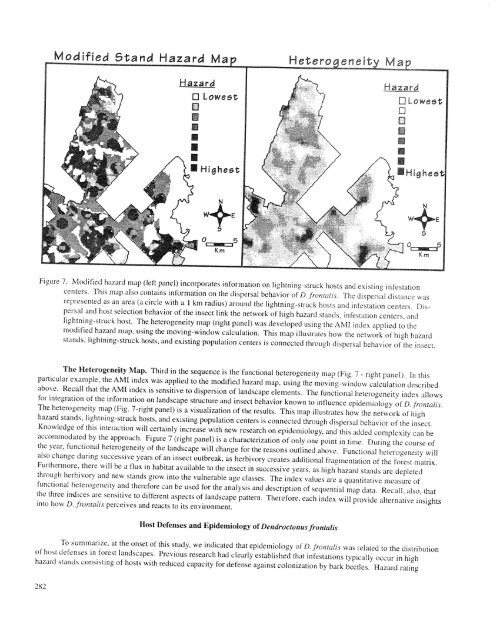View or print this publication - Northern Research Station - USDA ...
View or print this publication - Northern Research Station - USDA ...
View or print this publication - Northern Research Station - USDA ...
You also want an ePaper? Increase the reach of your titles
YUMPU automatically turns print PDFs into web optimized ePapers that Google loves.
Modified Stand Hazard Ma Here ene t<br />
Figure 7. Modified hazard map (left panel) inc<strong>or</strong>p<strong>or</strong>ates in:f<strong>or</strong>mation on lightning-struck hosts and existing infestation<br />
centers. This map also contains inf<strong>or</strong>mation on the dispersal behavi<strong>or</strong> of D. ¢?o_talis. The dispersal distance was<br />
represented as an area (a circle with a 1 km radius) around the lightning-struck hosts and infestation centers. Dis-<br />
persal and host selection behavi<strong>or</strong> of the insect link the netw<strong>or</strong>k of high hazard stands, infestation centers, and<br />
lightning-struck host. The heterogeneity map (right panel) was developed using the AMI index applied to the<br />
modified hazard map, using the moving-window calculation. This map illustrates how the netw<strong>or</strong>k of high hazard<br />
:stands, liglhtning-struck hosts, and existing population centers is connected through dispersal behavi<strong>or</strong> of the insect.<br />
The Heterogeneity Map. Third in the sequence is the functional heterogeneity map (Fig. 7 - right panel). In <strong>this</strong><br />
particular example, tile AMI index was applied to the modified hazard map, using the moving-window calculation described<br />
above. Recall that the AMI index is sensitive to dispersion of landscape elements. The functional heterogeneity index allows<br />
f<strong>or</strong> integration of the inf<strong>or</strong>mation on landscape structure and insect behavi<strong>or</strong> known to influence epidemiology of D. frontatis.<br />
The heterogeneity map (Fig. 7-right panel) is a visualization of the results. This map illustrates how the netw<strong>or</strong>k of high<br />
hazard stands_ lightni_g.-struck hosts, and existing population centers is connected through dispersal behavi<strong>or</strong> of the insect.<br />
Knowledge of <strong>this</strong> interaction will certainly increase with new research on epidemiotogy, and <strong>this</strong> added complexity can be<br />
accommodated by the approach, Figure 7 (right panel) is a characterization of only one point in time. During the course of<br />
the year, functional heterogeneity of the landscape will change f<strong>or</strong> the reasons outlined above. Functional heterogeneity will<br />
also change during successive years of an insect outbreak, as herbiv<strong>or</strong>y creates additional fragmentation of the f<strong>or</strong>est matrix.<br />
Furtherm<strong>or</strong>e, there will be a flux in habitat available to the insect in successive years, as high hazard stands are depleted<br />
through herbiv<strong>or</strong>y and new stands grow into the vulnerable age classes. The index values are a quantitative measure of<br />
ftmctional heterogeneity and theref<strong>or</strong>e can be used f<strong>or</strong> tile analysis and description of sequential map data. Recall, also, that<br />
the tt_ree indices are sensitive to dilYerent aspects of landscaPe pattern. Therefk)re, each index will provide alternative insights<br />
into how O_ ._f?ontatis perceives and reacts to its environment.<br />
Host Defenses and Epidemiology of Dendroctonus frontalis<br />
"Ik_summarize, at the onset of <strong>this</strong> study, we indicated that epidemiology of D. frontalis was related to the distribution<br />
of host defenses in f<strong>or</strong>est landscapes. Previous research had clearly established that infestations typically occur in high<br />
hazard stands consisting of hosts with reduced capacity f<strong>or</strong> defense against colonization by bark beetles. Hazard rating<br />
282
















